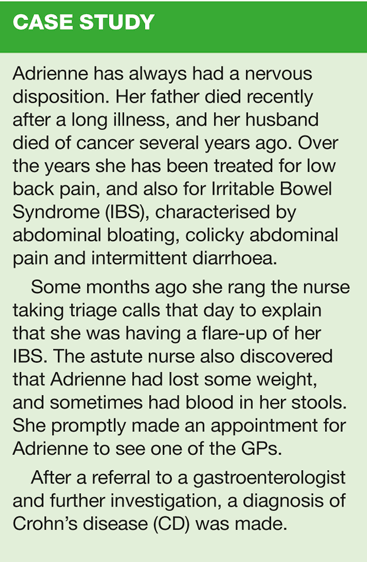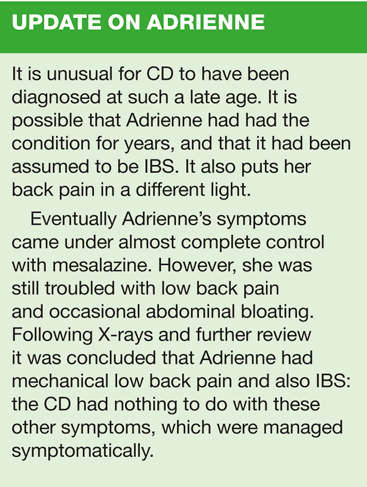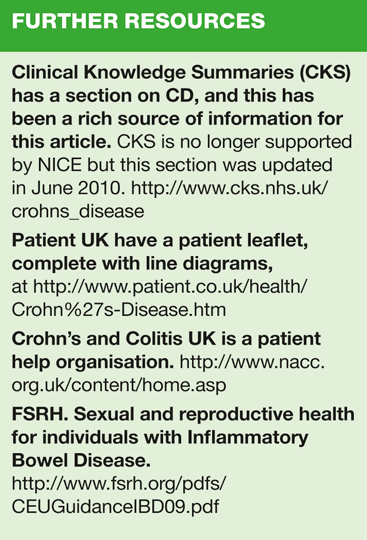Prescribing in Crohn's disease
Dr Ed Warren
Dr Ed Warren
FRCGP
GP in Sheffield, Trainer, Barnsley VTS
Crohn's disease is commonly managed in secondary care by gastroenterologists and specialist inflammatory bowel disease nurses, but there is a valuable shared care role for the practice team
Crohn's disease (CD) is one of the two main Inflammatory Bowel Diseases, the other being Ulcerative Colitis. CD is a chronic relapsing condition that may affect any part of the gastrointestinal tract from mouth to anus. The full thickness of the bowel wall is affected, but there are always sections of normal bowel in between these 'skip lesions'. Ulcerative colitis (UC) only affects the inner lining of the bowel. However, sometimes CD and UC are difficult to tell apart, a situation termed 'indeterminate colitis'.
The number of new cases of CD that are diagnosed each year in the UK is 83 per million and the UK prevalence (the number of people who have CD at any one time) is 1,450 per million.1 This is about half the incidence and prevalence of UC. A general practice of 8,000 patients will only have around 5 patients with CD. The sexes are equally affected, and the commonest age at diagnosis is 30 years.2
CD can affect parts of the body other than the gastrointestinal tract in 20% to 40% of cases.3
- A third of sufferers get inflammatory arthritis, and this is not connected with the severity of the bowel symptoms.
- The risk of osteoporosis increases, both because of CD, but also because of the treatments used for it. There is a 40% increased risk of fractures.
- Two painful skin conditions - erythema nodosum and pyoderma gangrenosum - are more common in CD.
- Episcleritis and scleritis are both more common in CD - these are sometimes confused with conjunctivitis.
It is not known exactly what causes CD, and a mixture of genetic and environmental causes is postulated.4 For example, there are known risks for contracting CD:
- Smoking roughly doubles the risk.5
- In patients with CD, there is a 25% to 40% chance that there is a family history of the disease. If a sibling has CD, the risk of developing CD is 17 to 35 times the population average.6
- If you have your appendix removed, then the risk increases sevenfold in the subsequent year, and only returns to normal after 5 years.7
- Taking non-steroidal anti-inflammatory drugs may increase the risk of relapse.
- Taking the Combined Oral Contraceptive Pill increases the risk of CD by about 50%, which sounds a lot but as CD is quite rare this is not enough to affect prescribing.8
CD is named after Burrill Bernard Crohn, a New York gastroenterologist who described 14 cases of his eponymous disease in 1932.
DRUG TREATMENTS
All patients with CD need referral to a secondary care specialist. There is no role for general practice initiating disease-modifying drugs for the condition.9 That is not to say that drugs are not prescribed from general practice - these might be symptomatic medications like pain killers or anti-diarrhoea drugs, or more specific targeted drugs under a 'shared care' arrangement with hospital colleagues. There is also a role for primary care workers to encourage sufferers to adhere to their treatment regime (40% do not), and to co-ordinate care and deal with symptom exacerbations. Many gastroenterology departments employ specialist Inflammatory Bowel Disease nurses to facilitate communication with primary care and to offer rapid access when patients encounter problems.
Left alone, nearly 20% of people with CD will go into remission without treatment, so doing nothing is certainly an option.10 However, the remaining 80% of patients will need treatment. The aims of treatment are to obtain and maintain remission. Sometimes remission can only be achieved by surgery, and surgery may also be needed to deal with complications such as strictures or fistulas. In addition, extra treatments may be needed to deal with the manifestations of CD that occur outside the bowel.
Aminosalicylates
The two aminosalicylates indicated for use in CD in the UK are sulfasalazine and mesalazine. They do not help induce remission or maintain a medically-induced remission, but are useful after surgically-induced remission. The drugs are given by mouth. Users need regular blood counts as the drugs can suppress white and red cell production. Monitoring will be specified from secondary care, but may be delegated to the practice. As well as a blood count, LFT and U&E measurements are needed regularly. Blood will be taken every 3 months at first, with intervals increasing if all remains well. Unexplained bleeding, bruising, sore throat, fever or malaise should be reported to the practice without delay. Ironically, these drugs can cause abdominal pain and diarrhoea, especially at higher doses, as well as discolouring urine and contact lenses. Aminosalicylates are not interchangeable and should be prescribed according to their mode and site of action, and the brand name should always be specified.
Corticosteroids
Corticosteroids in short courses are good at inducing remission in Crohn's, but do not prevent relapses so should be stopped once remission has been achieved.11 Topical treatments (enemas) have fewer side effects and are preferred. If oral treatment is needed, up to a staggering 60mg prednisolone a day may be required. Used topically, patients over 2 years can use a twice daily 5mg Predsol (prednisolone) suppository, and adults can use a 20mg Predsol retention enema once a day. Oral corticosteroids can cause diabetes, hypertension, gastric irritation (may be used with a proton pump inhibitor), glaucoma, and osteoporosis. They can also induce mental changes. Topical steroids can also cause problems due to systemic absorption. People on prolonged steroids, or needing regular short courses, will need checks for diabetes, blood pressure and (in children) effects on growth. They may also need more drugs to prevent osteoporosis.
Azathioprine and mercaptopurine
Both drugs alter antibody production, and are used orally in CD where it has not been possible to reduce oral prednisolone sufficiently. They may take up to 12 weeks to work and are typically taken for 3-4 years. Azathioprine can cause a flu-like hypersensitivity syndrome (dizziness, diarrhoea, vomiting, fever, rigors) after 2-3 weeks of use. Both can suppress white blood cell production and increase susceptibility to infections. A full blood count and liver function tests should be done within 4 weeks of starting treatment and then every 6-12 weeks thereafter. U&E is needed every 6 months.
Methotrexate
Methotrexate is taken as a tablet or tablets once a week. There is also an injection. It is usually used in those taking high doses of steroids but who cannot take azathioprine or mercaptopurine. It can take several weeks to build up an effect, and some require it for several years. Side effects of nausea, vomiting, diarrhoea and a sore mouth can be reduced by also taking folic acid at a different time in the week. Methotrexate can also cause liver damage, lung inflammation and reduce blood cell production. Monitoring consists of being alert for side effects, monthly FBC and LFT, and 6 monthly U&E.
Infliximab and adalimumab
These drugs are anti-tumour necrosis factor (TNF) agents that reduce inflammation. They are used in severe CD that has not responded to other treatments and in whom surgery is not advised. They carry a heavy burden of adverse effects including infection, blood abnormalities, liver and lung problems, heart failure and cancer. To monitor treatment blood tests are required monthly: FBC, LFT, ESR, U&E.
Antibiotics
Ciprofloxacin and metronidazole are used to reduce infections in anal CD.
Anti diarrhoea drugs
This would seem to be a logical treatment approach. However, loperamide and codeine are only safe in CD if the colon is not involved as otherwise they increase the risk of toxic megacolon - the colon is grossly enlarged, with fever, shock and abdominal distension.
SHARED CARE
Patients with Crohn's disease will often be distressingly familiar with the symptoms it causes. Typically there is a looseness of the stools with diarrhoea, often with blood or mucus, sometimes with tenesmus (a need to pass stool though the rectum is empty) or rectal pain. There is also abdominal pain. Symptoms will vary between patients, but most people - after the first few episodes - will readily recognise when a flare-up is occurring. The usual policy with a flare-up is to make prompt contact with the primary care practice. However, some patients will have alternative direct access to specialist nursing services. It is also sometimes possible for sufferers to have an emergency supply of corticosteroids to use. The circumstances when they should use this treatment must be discussed and it is not an alternative to accessing specialised services, merely a stop-gap. Co-ordination between the different services, and an agreed shared management plan, are essential components of the best care of Crohn's disease.
FLARE-UP OF SYMPTOMS
When CD flares up, it is often so severe that admission to hospital is needed. If this is not the case then there may be some scope for prescribing from general practice.
- Could it be something else? Other illnesses mimic the symptoms of CD, particularly infections.
- Is the patient taking medication as prescribed? Poor adherence will promote a flare up.
- Has the patient tried anything so far? If it is working, then it might be worth continuing.
- What treatment worked last time? Treatment is usually only started after communication with the specialist involved, but in some instances a short course of oral steroids might bring the situation under control.
CONCLUSION
CD is mercifully quite rare with each general practice only having a handful of cases on their list. Severity can range from people who are mildly affected who respond well to treatment or even have a spontaneous remission and go on to lead normal lives with a minimum of problems or medication, to the more severe end with sufferers requiring regular hospital admissions and repeated surgery to remove ever more affected bowel. So though rare, CD is very significant to those who have it and we owe them our best attentions.
Our hospital colleagues are in the driving seat when it comes to starting treatments, and once diagnosed all patients with CD will be under hospital review. The drugs used all have potentially serious side effects and require regular monitoring. It makes sense that monitoring goes on in general practice, a task which will often fall to the practice nurse. It is necessary to be alert when things are going wrong.
REFERENCES
1. Loftus EV Jr. Clinical epidemiology of inflammatory bowel disease: Incidence, prevalence, and environmental influences. Gastroenterology 2004;126(6):1504-1517
2. IBD Standards Group (2009) Quality care: service standards for the healthcare of people who have inflammatory bowel disease (IBD). IBD Standards Group. Available at: http://www.ibdstandards.org.uk/ibd-standards.asp
3. Evans PE, Pardi DS. Extraintestinal manifestations of Inflammatory Bowel Disease: Focus on the musculoskeletal, dermatologic, and ocular manifestations Med Gen Med 2007; 9(1): 55
4. Abraham C, Cho JH. Inflammatory bowel disease. New Engl J Med 2009;361(21):2066-2078
5. Mahid SS, Minor KS, Soto RE, et al. Smoking and inflammatory bowel disease: a meta-analysis. Mayo Clin Proc 2006;81(11):1462-1471
6. Akobeng AK. CD: current treatment options. Arch Dis Child 2008;93(9):787-92.
7. Kaplan GG, Jackson T, Sands BE, et al. The risk of developing CD after an appendectomy: a meta-analysis. Am J Gastroenterol 2008;103(11):2925-2931
8. FSRH (2009a) UK medical eligibility criteria for contraceptive use. Faculty of Sexual and Reproductive Healthcare . Available at: http://www.fsrh.org/pdfs/UKMEC2009.pdf
9. Clinical Knowledge Summaries. Crohn's disease. Available at: http://www.cks.nhs.uk/crohns_disease
10. Su C, Lichtenstein GR, Krok K, et al. A meta-analysis of the placebo rates of remission and response in clinical trials of active CD. Gastroenterology 2004;126(5):1257-1269
11. Cummings JR, Kesav S, Travis SP. Medical management of CD. BMJ 2008; 336(7652):1062-1066
Related articles
View all Articles


